 W
WAcanthoceras is an extinct cephalopod genus belonging to the subclass Ammonoidea and family Acanthoceratidae that lived from the Albian to early Coniacian stages of the Cretaceous.
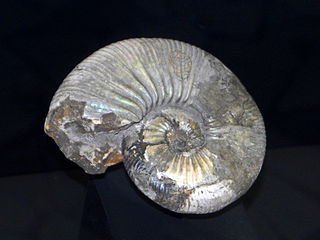 W
WAcanthohoplites is an extinct genus of ammonites in the family Parahoplitidae that lived in the Aptian and Early Albian stages of the Early Cretaceous.
 W
WActinoceramus is an extinct genus of fossil saltwater clams, marine pteriomorphian bivalve molluscs. These bivalves were facultatively mobile infaunal suspension feeders.
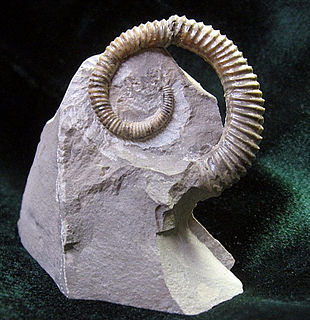 W
WAllocrioceras is an ammonoid cephalopod from the Turonian to Santonian stages of the Late Cretaceous, included in the turrilitoid family Anisoceratidae. Its shell is strongly ribbed and is in the form of a widely open spiral.
 W
WBasilemys is a large, terrestrial trionychoid turtle that was from the Upper Cretaceous time period. In Greek, the "Basil (name)" means royal or kingly and the word "Emys" means turtle. Therefore, Basilemys means King Turtle. The stratigraphic subdivisions of the Upper Cretaceous include Cenomanian, Turonian, Coniacian, Santonian, Campanian, and Maastrichtian. Basilemys was mostly from the Campanian and Maastrichtian subdivisions of the Cretaceous time period and is considered to be the largest terrestrial turtle of its time. This extinct genus of land turtles belongs to the family Nanhsiungchelyidae. Occurrences of Basilemys have largely been reported in the North America region. It is interesting to note that the family Nanhsiungchelyidae made its first appearance in the Lower Cretaceous in Asia and we know from Basilemys that this family appeared in the Upper Cretaceous in North America. The North American populations of Basilemys are considered to be immigrants from Asia through the Beringia during the Upper Cretaceous. In an analysis made by Sukhanov et al. on a new Nansiunghelyid turtle from the Upper Cretaceous of Mongolia, it was demonstrated that Asian nanhsiungchelyids gave rise to the North American nanhsiungchelyids. One genus from the family Nanhsiungchelyidae, Zangerlia, is similar to Basilemys in terms of skull proportions. However, Basilemys has a more complex triturating surface that includes well-defined pockets on the dentary. Basilemys also has tooth-like projections on the triturating surface of the maxilla.
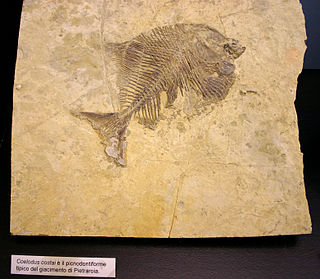 W
WCoelodus is an extinct genus of pycnodontiform fish from the Late Jurassic to early Paleocene (Danian). Fossils of the genus have been found in:JurassicGardies, FranceCretaceousYacoraite Formation, Argentina El Molino Formation, Bolivia Baharîje Formation, Egypt Ahlen and Bückeberg Formations, Germany Nimar Formation, India Alburni, Italy Damergou, Zinder, Niger Cochirleni Formation, Romania La Huérguina and Cabana Formations, Spain Pierre Shale, Kansas Tunbridge Wells Sand Formation, England Tucumcari Formation, New Mexico Twin Mountains and Paluxy Formations, TexasPaleoceneTremp Formation, Spain
 W
WConiophis is an extinct genus of snakes from the late Cretaceous period. The type species, Coniophis precedes, was about 7 cm long and had snake-like teeth and body form, with a skull and a largely lizard-like bone structure. It probably ate small vertebrates. The fossil remains of Coniophis were first discovered at the end of the 19th century in the Lance Formation of the US state of Wyoming, and were described in 1892 by Othniel Charles Marsh. For the genus Coniophis, a number of other species have been described. Their affiliation is, however, poorly secured, mostly based on vertebrae descriptions from only a few fossils.
 W
WCymatoceras is a wide-ranging extinct genus from the nautilitacean cephalopod family, Cymatoceratidae. They lived from the Late Jurassic to Late Oligocene, roughly from 155 to 23 Ma.
 W
WDiscoscaphites is an extinct genus of ammonite.
 W
WDouvilleiceras is a genus of ammonites from the Middle to Late Cretaceous. Its fossils have been found worldwide, in Africa, Asia, Europe, and North and South America.
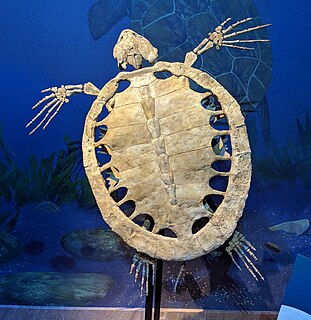 W
WEuclastes is an extinct genus of sea turtles that survived the Cretaceous–Paleogene mass extinction. The genus was first named by Edward Drinker Cope in 1867, and contains three species. E. hutchisoni, was named in 2003 but has since been reassigned to the genus Pacifichelys, while E. coahuilaensis named in 2009 was reassigned as Mexichelys coahuilaensis in 2010.
 W
WExogyra is an extinct genus of fossil marine oysters in the family Gryphaeidae, the foam oysters or honeycomb oysters. These bivalves grew cemented by the more cupped left valve. The right valve is flatter, and the beak is curved to one side. Exogyra lived on solid substrates in warm seas during the Jurassic and Cretaceous periods.
 W
WFagesia is a small, subglobular ammonite belonging to the vascoceratid family of the Acanthocerataceae that lived during the Turonian stage of the Late Cretaceous, 92-88 Ma ago.
 W
WGorgosaurus is a genus of tyrannosaurid theropod dinosaur that lived in western North America during the Late Cretaceous Period (Campanian), between about 76.6 and 75.1 million years ago. Fossil remains have been found in the Canadian province of Alberta and possibly the U.S. state of Montana. Paleontologists recognize only the type species, G. libratus, although other species have been erroneously referred to the genus.
 W
WThe Laramide orogeny was a period of mountain building in western North America, which started in the Late Cretaceous, 70 to 80 million years ago, and ended 35 to 55 million years ago. The exact duration and ages of beginning and end of the orogeny are in dispute. The Laramide orogeny occurred in a series of pulses, with quiescent phases intervening. The major feature that was created by this orogeny was deep-seated, thick-skinned deformation, with evidence of this orogeny found from Canada to northern Mexico, with the easternmost extent of the mountain-building represented by the Black Hills of South Dakota. The phenomenon is named for the Laramie Mountains of eastern Wyoming. The Laramide orogeny is sometimes confused with the Sevier orogeny, which partially overlapped in time and space.
 W
WLyelliceras is a genus of ammonites belonging to the family Lyelliceratidae. These cephalopods were fast-moving nektonic carnivores. They lived in the Cretaceous period, Albian stage.
 W
WMammites is a Late Cretaceous ammonite genus included in the acanthoceratoidean family, Acanthoceratidae, and the type genus for the subfamily Mammitinae. Mammites was named by Laube and Bruder in 1887.
 W
WThe Mancos Shale or Mancos Group is a Late Cretaceous geologic formation of the Western United States.
 W
WThe Manson crater is an impact crater near the site of Manson, Iowa where an asteroid or comet nucleus struck the Earth during the Cretaceous Period, approximately 74 Ma. It was one of the largest known impact events to have happened in North America. Previously it was thought to have led to the extinction of the dinosaurs until isotopic ages proved that it was too old.
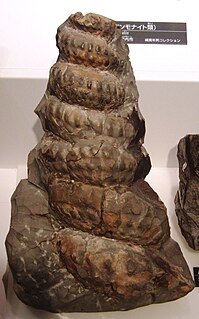 W
WMariella is an ammonoid genus, named by Nowak (1916) from the upper Albian and Cenomanian stages of the mid Cretaceous, included in the Turrilitidae. Its type is Turrilites bergeri
 W
WMenuites is a genus of extinct ammonites, forming a rather small offshoot of Anapachydiscus with a fairly widespread distribution from the Upper Cretaceous Santonian and Campanian stages.
 W
WMortoniceras is an ammonoid genus belonging to the superfamily Acanthocerataceae, named by Meek in 1876, based on Ammonites vespertinu, named by Morton in 1834.
 W
WPachydiscus is an extinct genus of ammonite from the Late Cretaceous with a worldwide distribution, and type for the desmoceratacean family Pachydiscidae. The genus' type species is P. neubergicus. Altogether some 28 species have been described.
 W
WPachyrhizodus is an extinct genus of ray-finned fish that lived during the Late Cretaceous in the Western Interior Seaway in North America and in Colombia, South America. The type species is P. basalis. The species P. etayoi, described in 1997 by María Páramo from the La Frontera Formation in Colombia, was named honouring Colombian geologist and paleontologist Fernando Etayo.
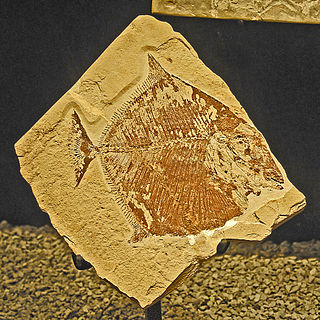 W
WPalaeobalistum is an extinct genus of prehistoric ray-finned fish which ranged from the Cretaceous to Eocene periods.
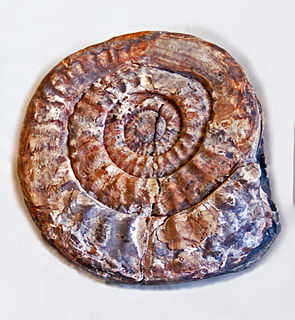 W
WPeroniceras is an ammonite belonging to the Ammonitida family Collignoniceratidae.
 W
WPhyllopachyceras is an extinct genus of ammonoid cephalopods belonging to the family Phylloceratidae. These nektonic carnivores lived in the Cretaceous, from Hauterivian to Maastrichtian to age.
 W
WPlatypterygius is an ichthyosaur of the family Ophthalmosauridae. It is most closely related to the genera Caypullisaurus and Brachypterygius. The ichthyosaur lived from the Early Cretaceous (Hauterivian) to the earliest Late Cretaceous (Cenomanian) and had a cosmopolitan distribution.
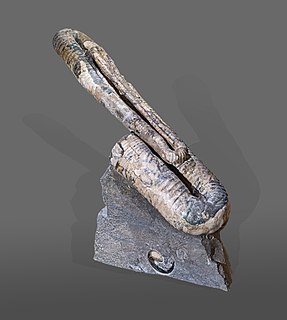 W
WPolyptychoceras is an extinct genus of ammonites from the Late Cretaceous of Asia, Europe, and North and South America. It was first named by Hisakatsu Yabe in 1927.
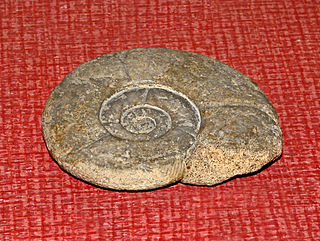 W
WPuzosia is a genus of desmoceratid ammonites, and the type genus for the Puzosiinae, which lived during the middle part of the Cretaceous, from early Aptian to Maastrichtian. Sepkoski defines the range from Albian to Santonian. The generic name comes from the Serbian words "Puž" (snail) and "oce/ose" (axis), gaining its name from the shell's snail-like appearance.
 W
WScalarites is a genus of heteromorph ammonites included in the family Diplomoceratidae. These fast-moving nektonic carnivores lived in the Cretaceous period, from 89.3 to 70.6 million years ago). These fossils have been found in Antarctica, Brazil, Denmark, Germany, Japan, Russia, Sweden and United States.
 W
WSphenodiscus is an extinct genus of acanthoceratacean ammonite. The genus has been found from many continents and is thought to have had a large global distribution during the Maastrichtian stage of the Late Cretaceous. It was one of the last ammonoids to have evolved before the entire subclass became extinct at the end of the period during the Cretaceous–Paleogene extinction event.
 W
WVascoceras is an extinct genus of Cretaceous ammonites included in the family Vascoceratidae. These fast-moving nektonic carnivores lived in the Cretaceous period from the late Cenomanian to the early Turonian. The type species of the genus is Vascoceras gamai from Portugal.
 W
WWeichselia is an extinct genus of fern. They were abundant from the Middle Jurassic to Early Cretaceous. While generally considered members of Matoniaceae, research has suggested that they have closer affinites to the Marattiales.
 W
WXiphactinus is an extinct genus of large predatory marine bony fish that lived during the Late Cretaceous. When alive, the fish would have resembled a gargantuan, fanged tarpon. The species Portheus molossus described by Cope is a junior synonym of X. audax. Skeletal remains of Xiphactinus have come from the Carlile Shale and Greenhorn Limestone of Kansas, and Cretaceous formations all over the East Coast in the United States, as well as Europe, Australia, the Kanguk and Ashville Formations of Canada,, La Luna Formation of Venezuela and the Salamanca Formation in Argentina.
 W
WThe Yellowstone hotspot is a volcanic hotspot in the United States responsible for large scale volcanism in Idaho, Montana, Nevada, Oregon, and Wyoming as the North American tectonic plate moved over it. It formed the eastern Snake River Plain through a succession of caldera-forming eruptions. The resulting calderas include the Island Park Caldera, the Henry's Fork Caldera, and the Bruneau-Jarbidge caldera. The hotspot currently lies under the Yellowstone Caldera. The hotspot's most recent caldera-forming supereruption, known as the Lava Creek eruption, took place 640,000 years ago and created the Lava Creek Tuff, and the most recent Yellowstone Caldera. The Yellowstone hotspot is one of a few volcanic hotspots underlying the North American tectonic plate; another example is the Anahim hotspot.
 W
WZamites is a genus of fossil tree known from the Mesozoic of North America, Europe and India through the Eocene of North America. It is a form taxon for leaves that resemble the extant cycad Zamia. The fronds are linear or lanceolate in shape, and pinnately compound, with pinnae with parallel veins and smooth margins, and symmetrical and constricted at the base where they are attached obliquely to the upper surface of the rachis. It has been interpreted as a cycad in the family Cycadaceae or a Bennettitalean plant.